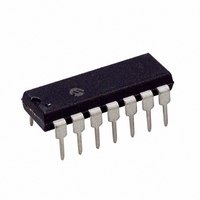TC9400CPD Microchip Technology, TC9400CPD Datasheet - Page 8

TC9400CPD
Manufacturer Part Number
TC9400CPD
Description
IC V-FREQ/FREQ-V CONV 14DIP
Manufacturer
Microchip Technology
Type
Volt to Freq & Freq to Voltr
Specifications of TC9400CPD
Package / Case
14-DIP (0.300", 7.62mm)
Frequency - Max
100kHz
Full Scale
±40ppm/°C
Linearity
±0.05%
Mounting Type
Through Hole
Supply Voltage (max)
15 V
Supply Voltage (min)
8 V
Maximum Operating Temperature
70 C
Minimum Operating Temperature
0 C
Dual Supply Voltage
+/- 5 V
Full Scale Frequency
100 KHz
Linearity Error
+/- 0.25 % FSR
Maximum Dual Supply Voltage
+/- 7.5 V
Minimum Dual Supply Voltage
+/- 4 V
Mounting Style
Through Hole
Operating Supply Voltage
9 V or 12 V
Lead Free Status / RoHS Status
Lead free / RoHS Compliant
Lead Free Status / RoHS Status
Lead free / RoHS Compliant, Lead free / RoHS Compliant
Other names
158-1140
158-1140
158-1140
Available stocks
Company
Part Number
Manufacturer
Quantity
Price
Company:
Part Number:
TC9400CPD
Manufacturer:
MIT
Quantity:
6 234
Part Number:
TC9400CPD
Manufacturer:
TELCOM
Quantity:
20 000
TC9400/9401/9402
3.0
3.1
The TC9400 V/F converter operates on the principal of
charge balancing. The operation of the TC9400 is
easily understood by referring to
voltage (V
resistor. This current is then converted to a charge on
the integrating capacitor and shows up as a linearly
decreasing voltage at the output of the op amp. The
lower limit of the output swing is set by the threshold
detector, which causes the reference voltage to be
applied to the reference capacitor for a time period long
enough to charge the capacitor to the reference volt-
age. This action reduces the charge on the integrating
capacitor by a fixed amount (q = C
the op amp output to step up a finite amount.
At the end of the charging period, C
This dissipates the charge stored on the reference
capacitor, so that when the output again crosses zero,
the system is ready to recycle. In this manner, the con-
tinued discharging of the integrating capacitor by the
input is balanced out by fixed charges from the refer-
FIGURE 3-1:
DS21483D-page 8
INPUT
DETAILED DESCRIPTION
Voltage-to-Frequency (V/F) Circuit
Description
0V –10V
V
IN
IN
) is converted to a current (I
50 kΩ
R
820 pF
IN
1 MΩ
Adjust
Offset
C
INT
+5V
-5V
10 Hz to 10 kHz V/F Converter.
510 kΩ
C
180 pF
REF
11
12
10 kΩ
5
3
2
Figure
REF
I IN
Zero Adjust
V
AMP OUT
Threshold
Detect
REF
-3V
REF
x V
12 pF
OUT
IN
is shorted out.
3-1. The input
REF
) by the input
), causing
100 kΩ
R
BIAS
Self-
Start
Threshold
Detector
Op Amp
–
+
I
BIAS
20 kΩ
60 pF
1
ence voltage. As the input voltage is increased, the
number of reference pulses required to maintain
balance increases, which causes the output frequency
to also increase. Since each charge increment is fixed,
the increase in frequency with voltage is linear. In
addition, the accuracy of the output pulse width does
not directly affect the linearity of the V/F. The pulse
must simply be long enough for full charge transfer to
take place.
The TC9400 contains a “self-start” circuit to ensure the
V/F converter always operates properly when power is
first applied. In the event that, during power-on, the op
amp output is below the threshold and C
charged, a positive voltage step will not occur. The op
amp output will continue to decrease until it crosses the
-3.0V threshold of the “self-start” comparator. When
this happens, an internal resistor is connected to the op
amp input, which forces the output to go positive until
the TC9400 is in its normal Operating mode.
The TC9400 utilizes low-power CMOS processing for
low input bias and offset currents, with very low power
dissipation. The open drain N-channel output FETs
provide high voltage and high current sink capability.
-5V
Delay
3 ms
4
V
+5V
V
SS
DD
Reference Voltage
14
(Typically -5V)
V
7
REF
÷
2
TC9400
TC9401
TC9402
GND
© 2007 Microchip Technology Inc.
6
Common
Output
F
OUT
F
OUT
/2
8
10
9
+ 5V
+ 5V
REF
R L
10 kΩ
R L
10 kΩ
is already












